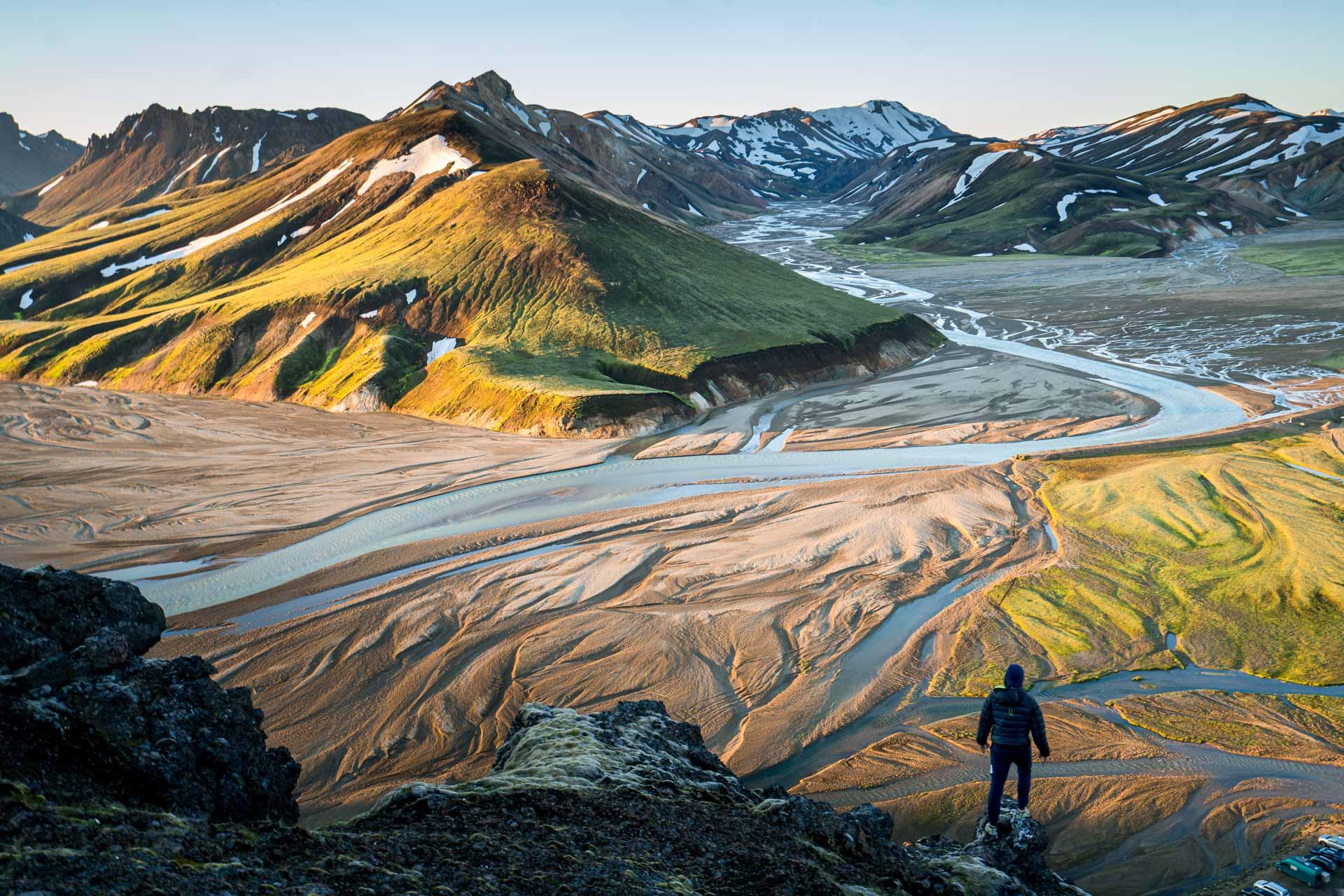Hiking Iceland's Volcanoes: Your Ultimate Guide
| DISCOVER ICELAND, All, Travel Guide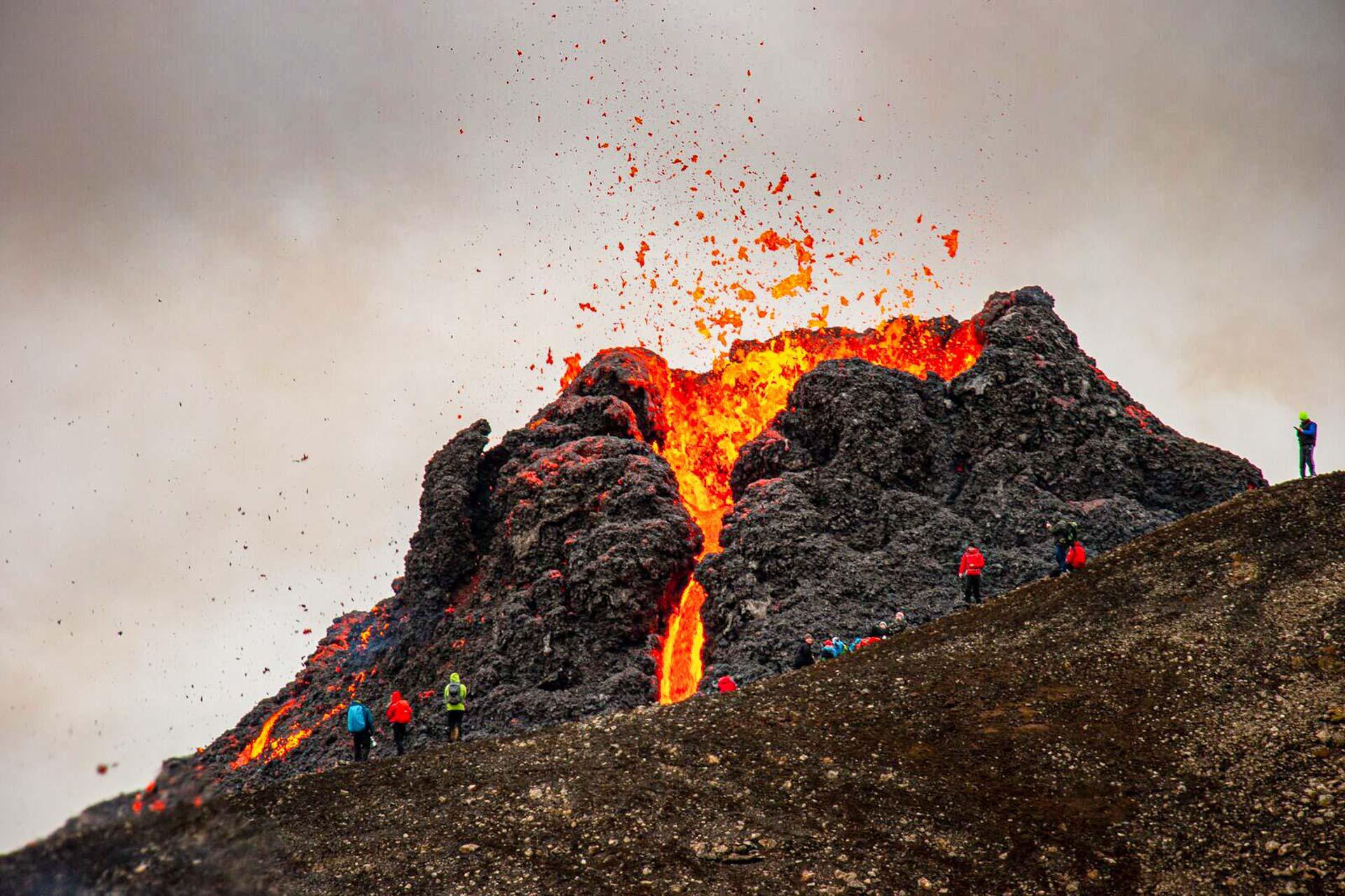
Geldingadalir / Fagradalsfjall Volcano erupting in Iceland
Table of Contents
Iceland's unique blend of volcanic and climatic elements creates a captivating landscape for travellers. Upon arrival at Keflavík International Airport, the distinctive terrain, marked by expansive rocky plains and majestic mountains, immediately captures your attention.
Iceland's natural environment can be described as "otherworldly," with its striking landscapes fueled by the magma from numerous active volcanoes. Join us as we delve into what makes Iceland a truly remarkable destination.
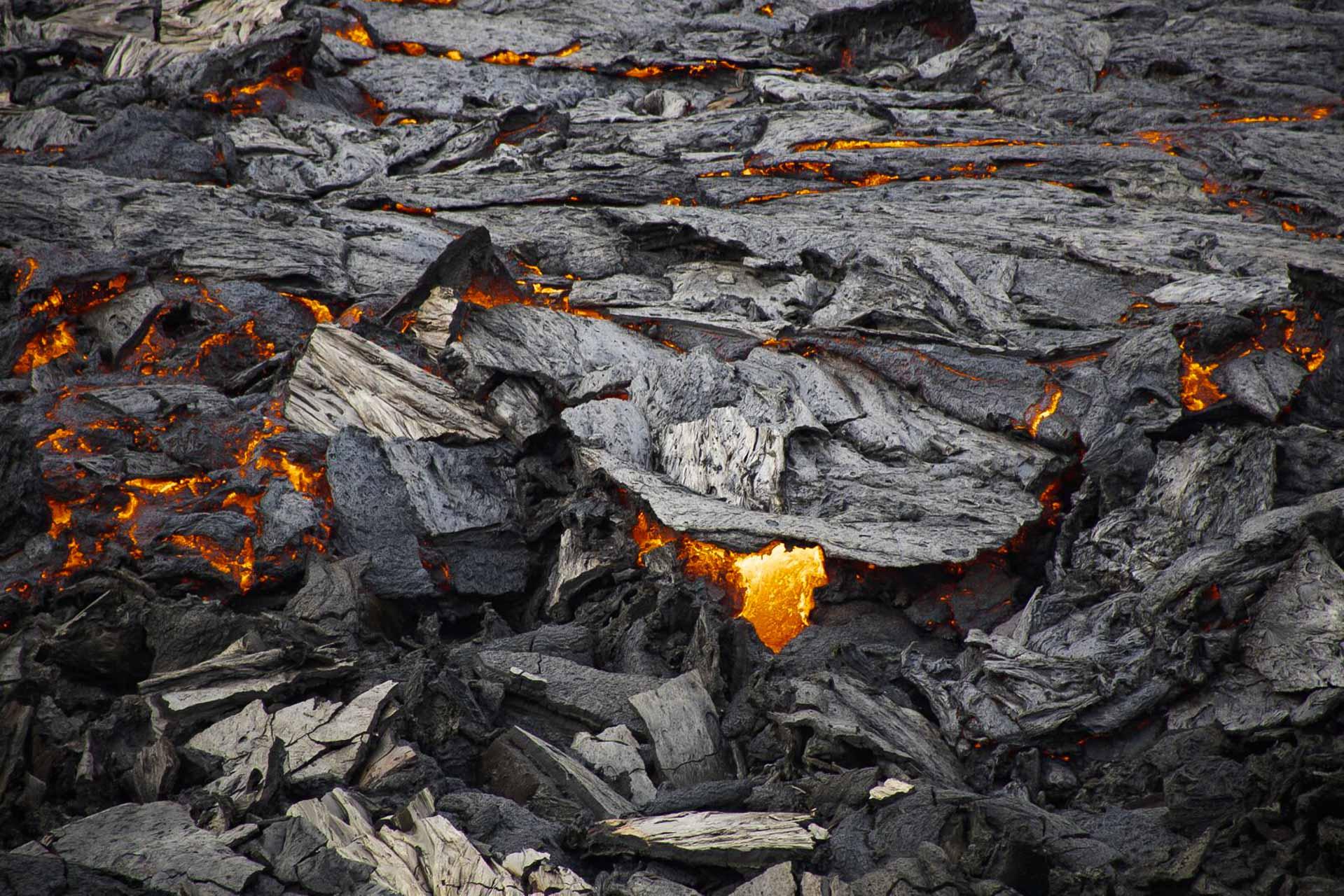
Glowing red lava under a layer of solidified lava - a reason you must never step on the new lava at Fagradalsfjall
What makes Iceland so explosive?
Iceland's unique location on the Mid-Atlantic Ridge, where the North American and Eurasian plates drift apart, results in a high concentration of active volcanoes. With over 30 active volcanic systems, Iceland experiences frequent eruptions, averaging one every five years.
Home to more than 130 volcanic mountains, only 18 have erupted since the settlement, around 874. In addition to volcanic activity, Iceland experiences constant earthquakes due to its tectonic setting. While most quakes are small or occur in uninhabited areas, residents occasionally feel them. This was the case in 2021 when the Reykjanes Peninsula experienced numerous earthquakes and aftershocks leading up to the Fagradalsfjall eruption.
Volcanoes in Icelandic history and culture
Volcanoes feature prominently in Iceland's sagas and myths. One example is the 10th-century Eldgjá eruption, which allegedly caused a "volcanic winter" and subsequent hardship.
Geothermal energy, a product of volcanic activity, has significantly impacted Iceland's economy by providing electricity and heating. This renewable energy source has decreased fossil fuel dependence and attracted tourists interested in geothermal attractions.
Furthermore, volcanoes have shaped Iceland's landscape, creating some of the most stunning natural wonders in the world. From towering volcanic mountains to sprawling lava fields and geothermal pools, Iceland's unique geography draws tourists from around the world.
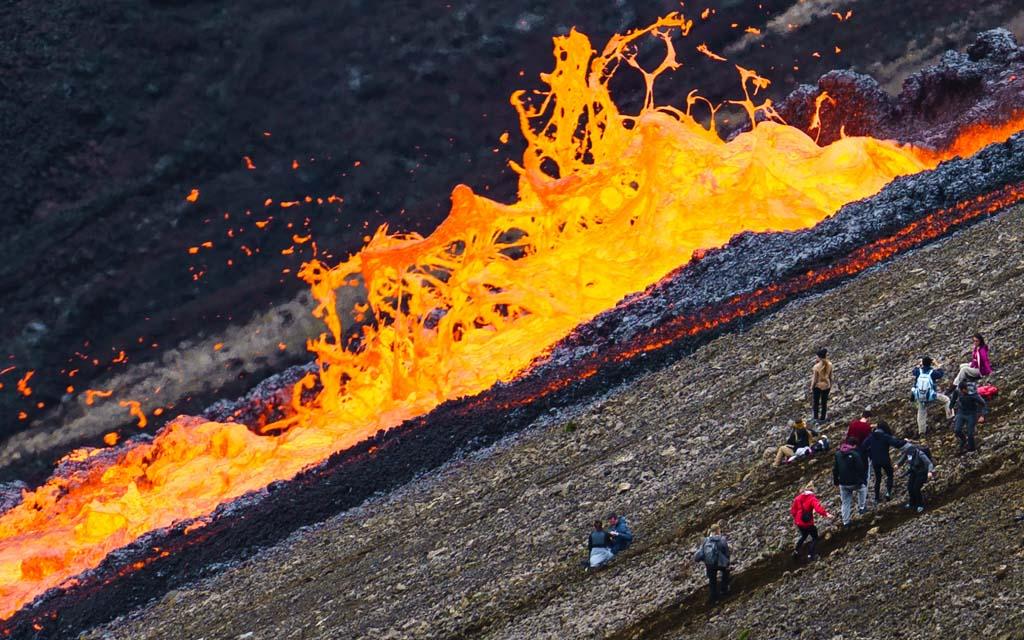
Hikers watching the eruption from up close
Famous Volcanoes in Iceland
Eyjafjallajökull
This volcano is located in southern Iceland and is famous for its eruption in 2010 that disrupted air travel across Europe. The eruption was preceded by months of seismic activity, and the eruption itself lasted for over a month. The ash plume disrupted air travel for over a week and had significant economic impacts.
Hekla
Hekla is one of Iceland's most active and famous volcanoes located in the south. It has erupted over 20 times since the settlement of Iceland in the 9th century. Hekla has played a significant role in Icelandic folklore and history. The volcano's most recent eruption occurred in 2000, and it's being closely monitored for signs of another eruption.
Katla
Katla is also located in the south and is one of the country's largest and most active volcanoes. The last time it erupted was in 1918, but it is believed to be overdue for another eruption. The volcanic activity of Katla is closely monitored. It is considered one of the most dangerous volcanoes in Iceland due to the potential for devastating floods caused by melting glaciers.
Askja
Askja is a caldera located in the central highlands and one of the most active volcanic systems. It has erupted numerous times throughout history. The most significant eruption occurred in 1875, which caused widespread devastation and forced many people to flee the surrounding area. Today, Askja is a popular destination for hikers and tourists due to its stunning scenery and unique geological features.
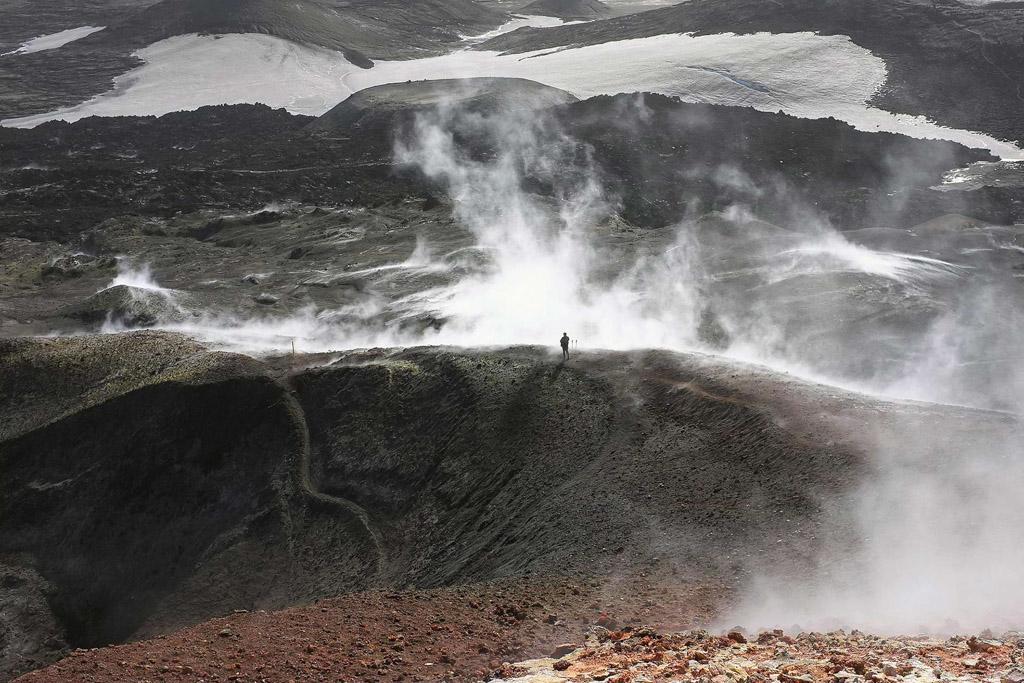
The ground around the Fimmvörduháls pass was still smoking a few years ago
Hiking Trails to Volcanoes in Iceland
There are plenty of great volcanic hiking trails in the land of fire; here are some of our favourite ones:
Reykjanes eruption sites
The Reykjanes volcano, now known as one of Iceland's most dynamic attractions, first awakened from an 800-year slumber with the Fagradalsfjall eruption in 2021, in the COVID era. This gentle, effusive event lasted six months and drew thousands of eager hikers, revitalizing Icelandic tourism like a jolt of magma!
In 2022, the same region rumbled to life again with an eruption named Geldingadalir, after the valley where it sparked. As travel was getting back on its feet post-COVID, this mesmerizing 6-week spectacle attracted visitors from around the world.
Fast forward to 2023, and the site is yet again blazing with activity. The latest eruption, known as "Litli Hrútur," has only amplified the allure, offering visitors the most breathtaking hiking experiences of their lives. The combined eruptions have sculpted a magnificent lava field, still worth exploring even during dormant periods.
Several trails lead to these volcanoes and the surrounding lava fields. However, this fast-changing area requires that you stay updated about the current trail conditions. Be sure to check the current trails and conditions of this hike in advance for a safe and memorable experience. Join our hiking community on Facebook to stay updated with the latest information about these trails.
Come join our guided eruption hike tour, which includes a guided hike to the multi-eruption spectacle of Reykjanes. As this fiery giant is predicted to continue to thrill us with multiple eruptions over the next few decades, the question isn't if, but when will you come to witness this living geological marvel?
Fimmvörðuháls Trail
This 16-mile trail is considered one of the most challenging hikes in Iceland, but it rewards hikers with stunning views of two erupting volcanoes: Eyjafjallajökull and Fimmvörðuháls. The hike starts at Skógar and takes you through a diverse landscape of waterfalls, glaciers, and lava fields. Book your guided Fimmvörðuháls day hike here
Reykjadalur Hot Spring Hike
This 6-mile hike is a popular day trip from Reykjavik and leads to a geothermal valley with hot springs and bubbling mud pools. Along the way, hikers can enjoy panoramic views of the Reykjanes Peninsula and the Atlantic Ocean.
Askja Caldera Trail
This 8-mile trail takes hikers through the barren wilderness of the Icelandic highlands to the Askja Caldera, a massive volcanic crater filled with turquoise water. The trail is challenging, with steep climbs and rough terrain, but the reward is well worth the effort.
Eldfell Volcano Hike
Located on the island of Heimaey in the Westman islands, the Eldfell Volcano is a popular hiking destination that offers a glimpse into Iceland's volcanic history. The volcano erupted in 1973 in a catastrophic event that caused the evacuation of the entire island, reshaping the island's coastline.
The 1.5-mile trail takes hikers to the volcano's summit, where they can enjoy breathtaking views of the islands and the Atlantic Ocean.
Raufarhólshellir Lava Tunnel
Raufarhólshellir Lava Tunnel Hike: Raufarhólshellir is a lava tunnel located 30 minutes from Reykjavik. This 1.3 km (0.8 mile) short hike takes you through a unique underground lava tube formed over 5000 years ago. The trail is relatively easy, but the cave can be dark and narrow in some places. Explore the hidden Raufarhólshellir lava tunnel on a safe, guided tour
The Laugavegur trail
The Laugavegur trail is a popular 55-kilometre hike in Iceland that traverses through diverse landscapes, including geothermal areas and volcanic mountains. The hike starts in Landmannalaugar, known for its colourful rhyolite mountains and hot springs, and ends in Þórsmörk valley, surrounded by glaciers and volcanoes. The trek takes 3-4 days to complete and offers stunning views of lava fields, glaciers, and craters. Check the selection of our guided and self-guided Laugavegur tours.
Hvannadalshnúkur summit hike
The dome-shaped Hvannadalshnjúkur peak is a dramatic landmark located on the glacier-topped volcano, Öræfajökull in southeast Iceland. It’s not just the highest point on the crater rim; it’s also the highest point in the whole of Iceland. The summit stands at an impressive 2,110 meters (6,920 feet) and is a popular destination for experienced hikers and mountaineers seeking a challenging ascent.
The hike to Hvannadalshnúkur takes you through a dramatic volcanic landscape with views of glaciers, snow-capped peaks, and rugged terrain. The hike is considered difficult and requires proper equipment and a guide. Book Hvannadalshnúkur hike here.
Snæfellsjökull Summit Hike
Snæfellsjökull Summit Hike is a challenging and rewarding volcano hike. Snæfellsjökull is a stratovolcano located on the Snæfellsnes Peninsula, and its summit sits at an elevation of 1,446 meters (4,744 feet) above sea level. The hike to the summit is a difficult and steep ascent that requires good physical fitness and some mountaineering experience.
The climb to the summit takes around 5-7 hours and involves some challenging sections of loose rocks and steep inclines. However, the views from the top are breathtaking, with panoramic vistas of the surrounding mountains and glaciers, as well as the coastline and the Atlantic Ocean. Book your guided Snæfellsjökull Summit Hike with Icelandic Mountain Guides.

The best hikes in Iceland
Discover our dedicated blog post on the "Best Hikes in Iceland" to experience the full spectrum of Iceland's natural beauty. Uncover scenic trails, breathtaking views, and unforgettable adventures tailored for every level of hiking enthusiast.
Grimsvotn
Grimsvotn is an active volcano under Vatnajökull, the largest glacier in Europe. Grimsvotn has erupted over 20 times since the settlement of Iceland, with the most recent eruption occurring in 2011. The 2011 eruption caused significant disruptions to air travel. The ash cloud produced by the eruption spread across Europe, forcing the cancellation of thousands of flights.
Snaefellsjokull
Snaefellsjokull is a glacier-capped stratovolcano located on the Snæfellsnes Peninsula in western Iceland. Its last eruption occurred approximately 2000 years ago and has been dormant. Snaefellsjokull gained fame as the setting for Jules Verne's "Journey to the Center of the Earth."
Snaefellsjokull is also considered a sacred site in Icelandic mythology. It is said to be one of the seven energy centres of the Earth. Many visitors come to hike the glacier and experience the energy and mysticism of the mountain.
Reykjanes volcanic system: Fagradalsfjall and Geldingadalir
The Reykjanes peninsula is home to a volcanic system that was dormant for over 800 years. In 2021, a new eruption occurred in the area. It has significantly impacted Iceland's tourism industry and has drawn visitors from around the world to witness the spectacle. It lasted for six months and attracted thousands of visitors from all over the world.
In 2022, another eruption occurred in the same area that lasted for a few weeks. Both eruptions were gentle, mainly producing slow lava flows and didn't cause any disruptions. The Reykjanes volcano is being monitored closely, and there are signs that this volcano can erupt again at any time.
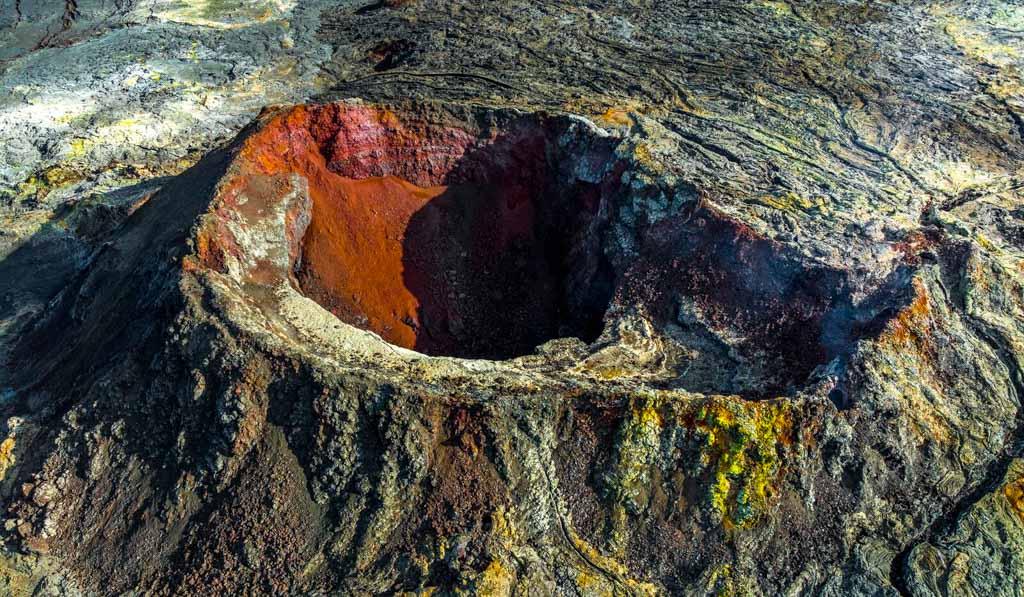
Fagradalsfjall volcanic crater after the eruption ended
Considering a guided volcano hike in Iceland?
Iceland's landscape is characterized by its remarkable volcanic and geothermal features, which demonstrate the immense power of nature. Exploring Iceland's volcanoes independently is always an option. However, to safely experience these wonders, it is beneficial to visit with an experienced guide.
A knowledgeable guide ensures safety, provides valuable information, and assists in capturing memorable photos. As Icelandic Mountain Guides, we are well-versed in our areas of expertise.
Our knowledgeable local guides provide fascinating information about Iceland's volcanoes and the country's natural wonders, enhancing the overall value of your journey. Moreover, they ensure a safe and enjoyable experience throughout your adventure.
Is it recommended to book in advance?
Absolutely! Booking your volcano tours in Iceland ahead of time is highly advised. Avoid disappointment by securing your spot on the tour of your choice before arriving in Iceland. If your desired tour is fully booked, Icelandic Mountain Guides can suggest alternative options catering to your interests.
Ensure you don't miss out on a remarkable adventure by reserving your place on the preferred tour at mountainguides.is.
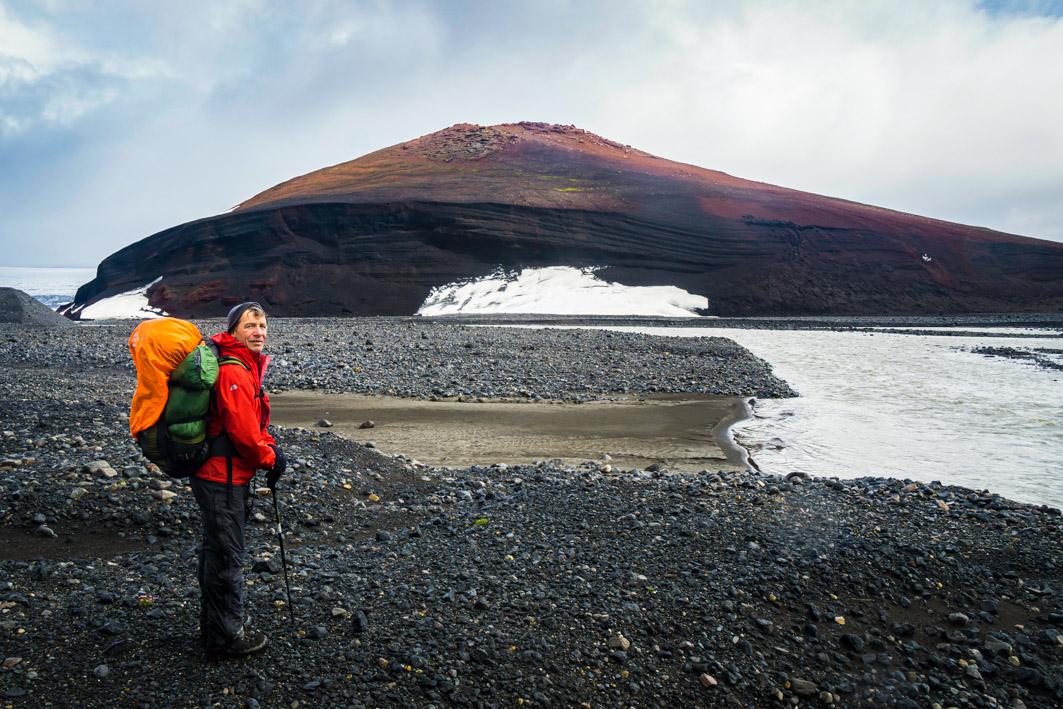
Moonlike volcanic landscape in the Highlands
Questions and answers about volcanoes in Iceland
How many active volcanoes are there in Iceland?
The island has 32 active volcanic systems with around 130–150 volcanic mountains. About 35 of these volcanoes have erupted over the last 10,000 years, and 11 have erupted in the previous century.
What are the 3 most active volcanoes in Iceland?
The three most active volcanoes in Iceland are Grímsvötn, Hekla, and Katla.
What volcanoes are still active in Iceland?
There are several active volcanoes in Iceland, including the three mentioned above, as well as Eyjafjallajökull and Fagradalsfjall, among others.
How often do volcanoes erupt in Iceland?
Volcanic eruptions in Iceland occur, on average, once every four to five years.
Is Fagradalsfjall still active?
At the time of this post (2023 July), the volcano in Reykjanes is erupting again, and the eruption is now named "Litli-Hrútur. Its current activity, however, would need to be checked with the Icelandic Meteorological Office.
Can you still see lava at Fagradalsfjall?
It is possible to see lava at Fagradalsfjall; however, if there is no eruption taking place, the lava you will see is solidified lava. That beating said it's still smoking hot and unsafe to walk unto. Please check the conditions at safetravel.is before heading to the eruption site.
Is Iceland just one big volcano?
Iceland is not just one big volcano; it is a geologically active island with multiple volcanoes.
How old is Iceland?
Iceland is around 25 million years old, with its oldest rocks dating back to the Tertiary Period.
Can I see lava in Iceland?
You can see fresh lava in Iceland during active eruptions. If there is no active eruption taking place at the time of your travel, you can still see vast fields of solidified lava, some of them covered in thick moss layers.
Does Iceland have a supervolcano?
There isn't a supervolcano in Iceland, but there are several large volcanic systems.
Are there earthquakes in Iceland?
Earthquakes are common in Iceland due to its location on the Mid-Atlantic Ridge. On average, Iceland records around 1,000 earthquakes per month, translating to approximately 33 earthquakes per day. This number can vary significantly depending on ongoing geological events.
Has a tsunami ever hit Iceland?
There have been no tsunamis recorded in Iceland's history.
What is the easiest volcano to see in Iceland?
The easiest active volcano to visit in Iceland is likely Fagradalsfjall. Located on the Reykjanes Peninsula, it is relatively close to Reykjavík, approximately 40 kilometres away. The recent eruption in 2021 has attracted many visitors. Established hiking trails lead to the site, making it accessible to visitors.
Keep me informed about the Icelandic Mountain Guides Blog
Outdoor adventure in Iceland is our specialty. Subscribe to our free monthly newsletter to learn when to go, what to do and where to have the best adventures in Iceland.
Related Blog Posts
Related Tours
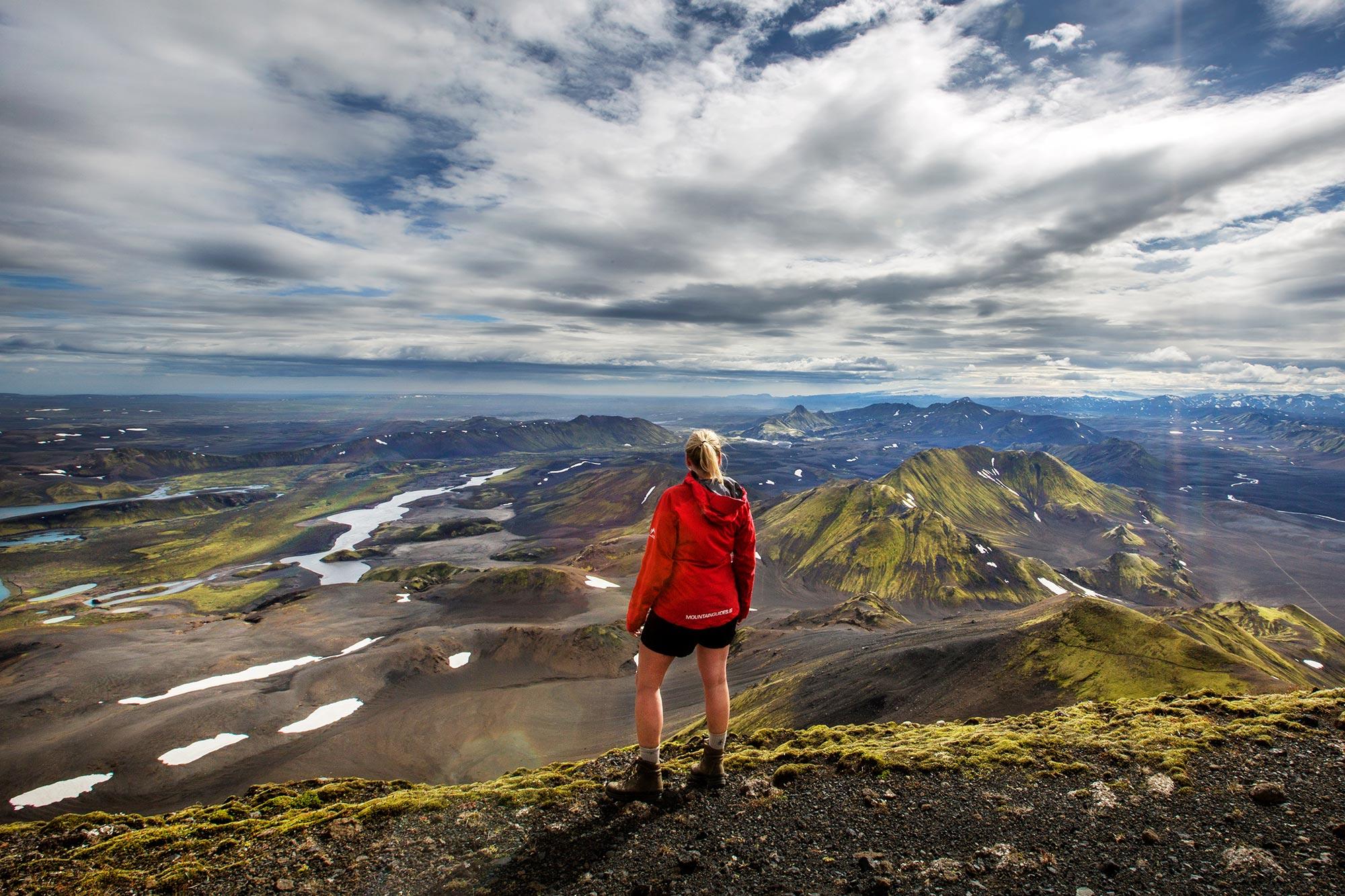
Volcanic Trails
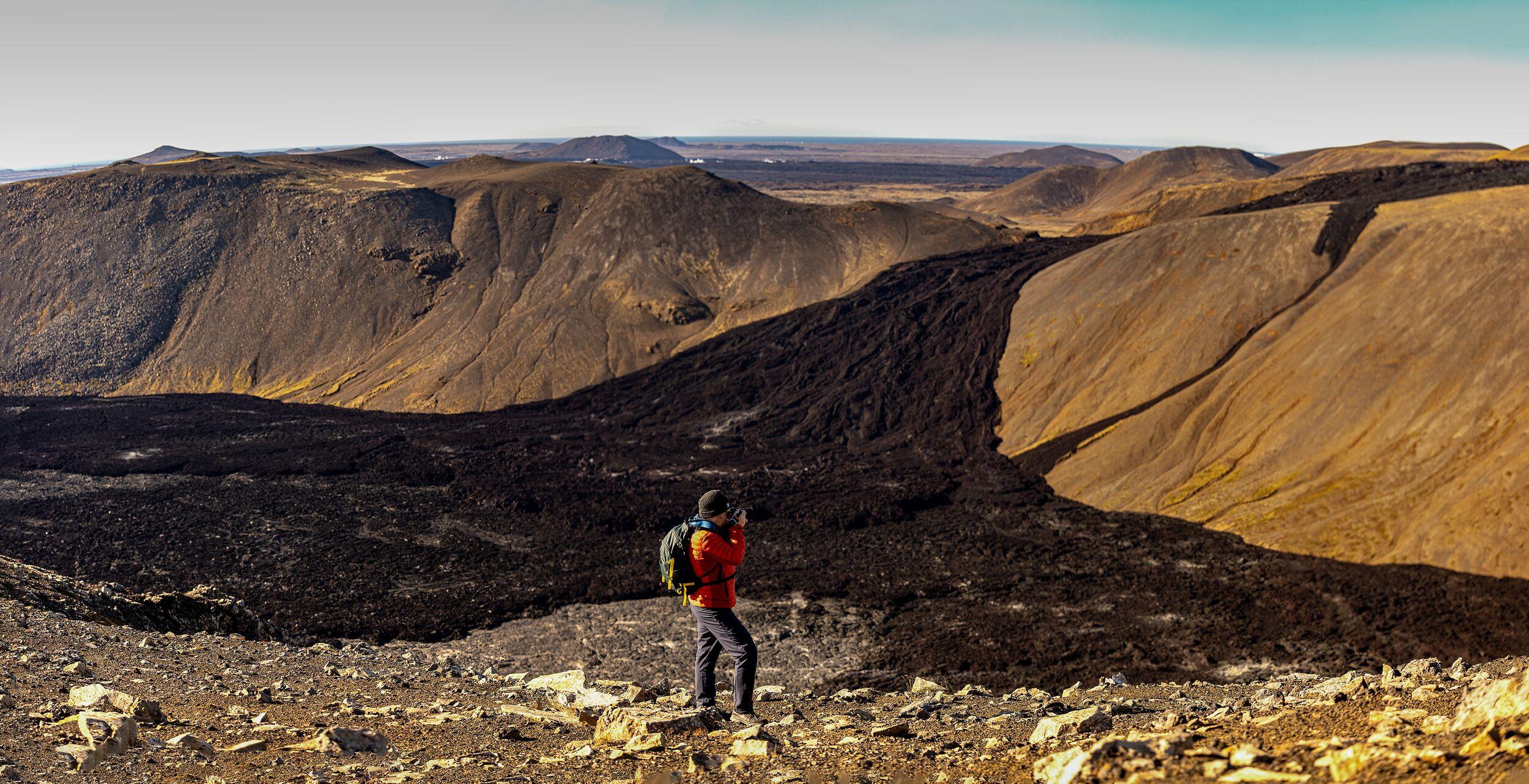
Reykjanes UNESCO Geopark Tour and Lava Hike


